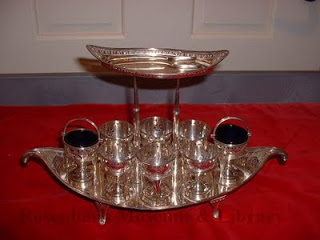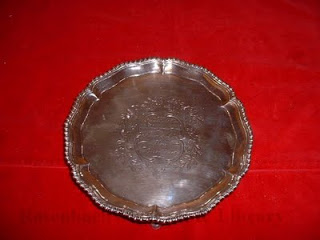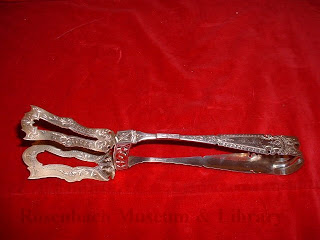Our newest exhibit, Friend or Faux, opens tomorrow and we’ll be kicking off our programming for the show this Saturday (11/14) at noon with the first of a series of seminars on authenticity. This inaugural seminar focuses on silver and will presented by David Barquist, Curator of American Decorative Arts at the Philadelphia Museum of Art. Dr. Barquist will be talking about methods of making and marking silver as well as looking at items that have been repaired or altered over the years. If you’re able to join us, please drop a note to [email protected]. It should be great!
I must confess that silver is one of my favorite media (thanks to studying with Winterthur’s curator emeritus Don Fennimore), so I thought I’d share a few tidbits from our collection, to whet your appetite for the treat to come this weekend.

Hester Bateman, egg cruet.1788/9. 1954.1813
This egg cruet is a favorite around here (just ask our curator Judy Guston about it) both because it is a beautifully made and delicate piece of silver and also because it was made by Hester Bateman, a famous female silversmith. Hester married John Bateman, a small time chain maker and silver worker, when she was fifteen and she assisted him with the business. John died in 1760, when Hester was 51 and she took over the business, greatly expanding it into a large family workshop, which she ran with her sons until she retired at the age of 81.

Myer Myers, salver. 1770-1772. 1954.892
Since David Barquist literally
wrote the book on Myer Myers, I figured I’d include this handsome salver (which is, in fact, in the book). Myer Myers is notable as a Jewish silversmith; as Barquist explains, Myers “was the first native English Jew in the British Empire to complete a formal apprenticeship and establish himself as a retail silversmith since the founding of the Worshipful Company of Goldsmiths in 1327.” He was also an incredibly prolific silversmith and an exceptionally talented one. One aspect of this salver which always fascinates me is that its inscription is in Dutch, even though it was made a hundred years after New York became an English colony.

Peter Krider, tongs. 1850-1860. 1954.1849
This piece is just fun. It is one of the amazingly elaborate and extremely specialized pieces of silverware which delighted the Victorians. It is clearly some form of tongs, possibly a vegetable or asparagus server. It has the added bonus of being a Rosenbach family piece–it was given by Rebecca Polock to her daughter, Mrs. A. S. Wolf.
That’s enough for now. I hope you can join us for more silver this weekend and you might also want to mark your calendars for additional seminars on January 9 (paintings); March 6 (manuscripts) and May 8 (books and prints).
 Hester Bateman, egg cruet.1788/9. 1954.1813
Hester Bateman, egg cruet.1788/9. 1954.1813
 Myer Myers, salver. 1770-1772. 1954.892
Myer Myers, salver. 1770-1772. 1954.892
 Peter Krider, tongs. 1850-1860. 1954.1849
Peter Krider, tongs. 1850-1860. 1954.1849
